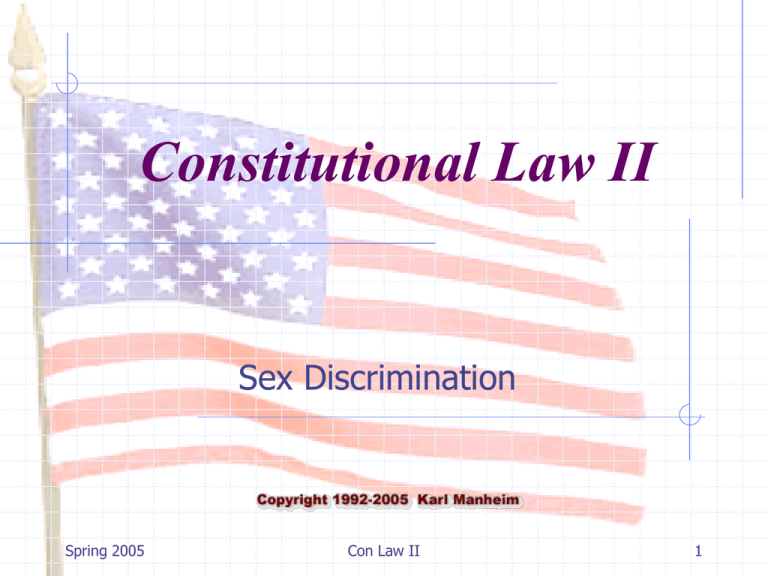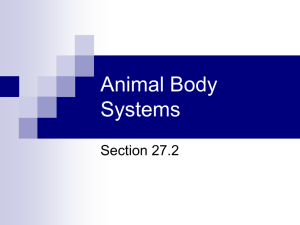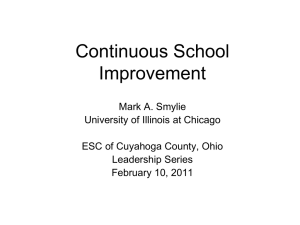US v. Virginia
advertisement

Constitutional Law II Sex Discrimination Spring 2005 Con Law II 1 Precursors Second-class citizens Women often could not enter into contracts, hold property, control their earnings, or sue e.g., Calder et ux. v. Bull et ux. (1798) Disenfranchised Neither 14th nor 15th amd gave the franchise Susan B. Anthony arrested in 1872 for trying to vote Spring 2005 Con Law II 2 Sufferage 19th Amendment (1920) Spring 2005 Con Law II 3 Precursors Early cases Bradwell v. State of Illinois (1972) Practicing law not a 14th amd. Privilege/Immunity Women unfit for the practice of law "The paramount destiny and mission of woman are to fulfill the noble and benign offices of wife and mother. This is the law of the Creator." Goesaert v. Cleary (1948) upholding law restricting women bartenders Paternalism Muller v. OR (1908) [upholding min wage for women Hoyt v. FL (1961) [jury exemption for women] Spring 2005 Con Law II 4 Emergence of Mid-Level Scrutiny Reed v. Reed (1971) Administrator preferred over adminstratrix State rationale: men were better w/ money Irrational? Worse than random? Spring 2005 Con Law II 5 Frontiero v. Richardson (1973) Females vs. Males as military dependents Who is discriminated against? Men or women? gets only Irrational? Or empirically based? 4 votes Administrative convenience not a shibboleth Suspect Class? – Indicia of Suspectness History of discrimination based on stereotype ongoing Structural impediments to political power Discrete and insular minority Discrete: high visibility of the characteristic Insular: no easy ingress/egress Spring 2005 Con Law II 6 Craig v. Boren (1976) Honk-n-Holler Convenience Store, Stillwater, OK Spring 2005 Con Law II 7 Craig v. Boren (1976) Curtis Craig (on Con right) Law II and his lawyers Spring 2005 8 Craig v. Boren (1976) 3.2% Beer Women: 18 + Men: 21 + Drunk Driving Men (18-20): 2% arrest rate Women: .18% arrest rate 93% of all DUI arrests are men 18 times as often Closeness of fit Underinclusiveness = .18% Overinclusiveness = 98% Spring 2005 Con Law II very good very bad 9 Craig v. Boren (1976) Is 98% overinclusiveness unconstitutional? I.e., is it a good proxy for people who are likely to drink and drive? Depends on the standard of review RB: For sure SS: No way Intermediate (mid-level) ? Mid-level “classifications by gender must serve important govt’l objectives and must be substantially related to achievement of those objectives” Spring 2005 Con Law II 10 US v. Virginia (1996) All-male VMI ENDS: prepare citizen soldiers MEANS: rigorous training (adversative method) which is unsuitable to women SCRUTINY: is exclusion of women “substantially related” to important gov’t interest? an “exceedingly persuasive justification” ? Spring 2005 Con Law II 11 US v. Virginia (1996) Is sex never a legitimate criterion? real biological differences unlike race, national origin Thus, sex can be a legitimate discriminator NB: one Because “sometimes” relevent (unlike race) of consequence heightened scrutiny Intermediate scrutiny Single-sex education is examination of actual ENDS Diversity in educ experieces but is this the “actual” purpose, or some posthoc rationalization Spring 2005 Con Law II 12 US v. Virginia (1996) ENDS: Benefits of adversative training would be lost in co-ed environment the “rat system” Why isn’t this benefit equally as important as ethnic diversity in law school? Inclusion vs Exclusion? Spring 2005 Con Law II 13 US v. Virginia (1996) REMEDY: Separate but equal at Equal? student body faculty curriculum (military orientation)? Alumni connections? Scalia (dissent) gender-based development differences can be recognized by a classification scheme decries radical egalitarianism Spring 2005 Con Law II 14 US v. Virginia Spring 2005 (1996) Con Law II 15 Gedulidig v. Aiello (1974) Proxy classifications Is pregnancy a proxy for sex Is defining disability not to include pregnancy discrimination based on sex? therefore, subject to mid-level scrutiny Men and women treated equally both denied pregnancy disability benefits Although men NEVER get pregnant, women don’t ALWAYS become pregnant i.e., there are SOME women in the benefited class Does that keep this from being sex-based discrim? Spring 2005 Con Law II 16 Gedulidig v. Aiello (1974) Proxy classifications Could the state exclude from disability coverage Tey-Sachs Disease Sickle Cell Anemia Hysterectomies (while funding vascectomies) Congress overrules Geduldig Pregnancy Discirmination Act Constitutional? Spring 2005 Con Law II 17 Michael M. v. Sup. Ct. (1981) Statutory rape Only men covered by criminal statute ENDS: health & welfare (of women) (teen pregnancy) An important interest MEANS: criminalize the conduct leading to teen preg.? criminalize one party to the conduct - men Spring 2005 Con Law II 18 Michael M. v. Sup. Ct. (1981) Statutory rape Only men covered by criminal statute ENDS: health & welfare (of women) (teen pregnancy) An important interest equalize risk and pain of teen pregnancy MEANS: criminalize the conduct leading to teen preg.? criminalize one party to the conduct – men classification is an excellent fit Spring 2005 Con Law II 19 Michael M. v. Sup. Ct. (1981) MEANS Is this classification (men only criminally liable) “substantially related” to the state’s goal Or would extending the burden to women to an even better job? Spring 2005 Con Law II 20 Rostker v. Goldberg (1981) 1. Standard of Review Intermediate (mid-levl) scrutiny tempered by court’s deference to congress in military/national security matters 2. Are ENDS Important? Raise & support armies including supplying combat troops 3. Are MEANS substantially related to ends? Conscription of men, not women Spring 2005 Is this invidious, based on bias or stereotype? Or because women are not eligible for combat? Con Law II 21 Rostker v. Goldberg (1981) Relatedness of MEANS to ENDS Register/draft only men therefore, men & women are not similarly situated why does even the dissent avoid this? perfect fit male-only troops the restriction on combat troops is statutory, and endorsed by Congress So how can there be any EP problems? Army consists of more than just combat troops in which case, exclusion of women from draft unnecessary Exclusion of women from combat itself violates EP Spring 2005 Male bonding a compelling interest? White male bonding? Con Law II 22 Rostker v. Goldberg (1981) Relatedness of MEANS to ENDS Register/draft only men good fit minimize opposition to draft & war Would drafting women subject war & war planning to greater public scrutiny? A principal object of equal protection is to equalize burdens Spreading the burden makes the political process a more effective means for correcting gov’t abuse Spring 2005 Con Law II 23 Califano v. Webster (1977) ENDS Social Security pension benefits Adjusted for social bias against women Is this a permissible/important END for congress? MEANS (classification) Calculating high wage period benefits women Standard of Review Still mid-level scrutiny, but AA often survives But see, e.g., Lamprecht v. FCC (DC Cir. 1992) (Thomas, Cir. Justice): WBE preference unconst’l despite Metro v. FCC (MBEs were const’l under midlevel scrutiny for cong’l AA), overruled by Adarand. Spring 2005 Con Law II 24 Spring 2005 Con Law II 25






